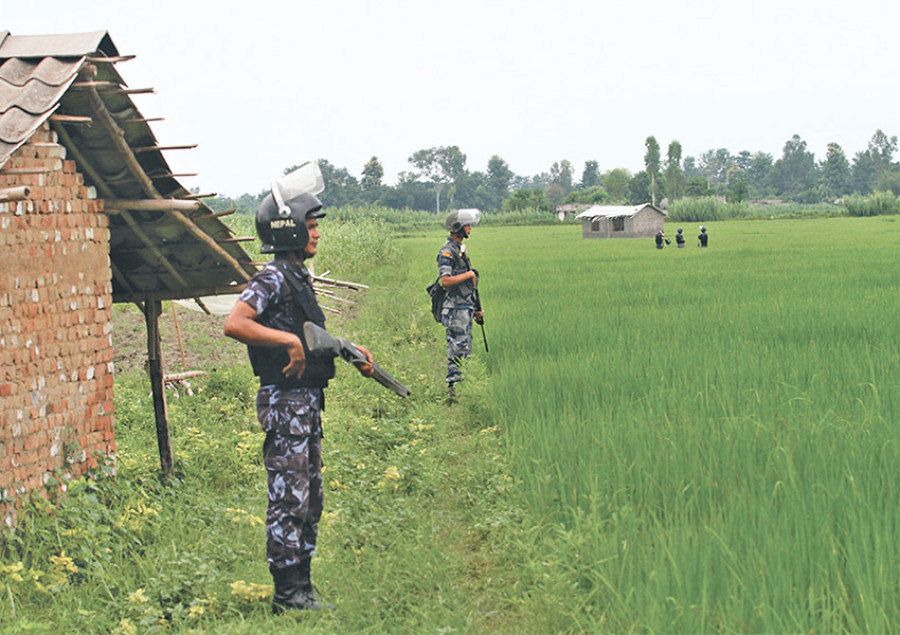Opinion
Edge of the precipice
Emerging from the ongoing political polarisation requires picking up one of two options on federal demarcation
Kanak Mani Dixit
The Maoists conducted what they said was class warfare. While they were opportunistic to take such recourse in a democratic, parliamentary state barely five years after it was achieved, at least the design of the proposed insurgency was such that it did not carry the danger of outright communal conflagration. As the polity grapples with the delineation of federal provinces today, however, the country teeters on the edge of that particular precipice.
There is no doubt, of course, that the state machinery, education sector and media is dominated by the Bahun caste more than anyone else, while making up 12 percent of the population, and this goes to the heart of the reality and perception of communitarian marginalisation in the country. This lies at the heart of disaffection among the ethnic and Madhesi communities, and yet the political leaders of the ‘democratic’ parties have not indicated over the years that they care enough to do something about it, other than grudgingly.
And yet we are still half-way to understanding the layered, inter-linked demographic complexity of the country. We have ingested a lot of anthropology to help understand what is going on, but not nearly enough of economics, history and political science to assist on the march towards a federal republic that gives identity-based rights/comfort as well as economic advancement. But, as often happens at times when identity politics are ascendant, it is not only the reality but the perception that counts.
Earlier, when Nepal had drifted towards ‘communal’ abyss, the mayhem was prevented not by human sagacity but by the sheer diversity of the populace and the need
for communities to hold on to the linkages that give them cultural, social and economic
sustenance. But as positions hardened over the years of attempted constitution-writing—as the state was weakened and the polity derailed by ‘syndicate politics’ and absence of elected local government—the situation is more dangerous now than perhaps ever before.
Prelude to Tikapur
The fact that national politics as well as federal demarcation has been defined by a cabal of top leaders rather than transparent debate on the floor of the Constituent Assembly (CA) meant that practically every CA member has been disempowered. In particular, the NC and UML did not give due responsibilities to their own winning MPs from the Tarai-Madhes, and hence could not generate the required momentum for federal demarcation of their choice.
It was when the Supreme Court single bench stayed the 16-point agreement’s plan of the four leading parties to hand over the task of federal delineation to an expert commission that they came up with the six province formula, which was tabled in the CA. Unexpectedly, it was the mid-western hills rather than the east-central Tarai-Madhes that erupted in protest, demanding a separation of the Karnali tract into its
own province.
Whereas, till now, the CA had been hobbled by the ‘Madhesbaadi’ leaders weakened by the November 2013 elections and seeking political survival, now the interest of powerful leaders of the Nepali Congress and CPN-UML came to the fore, with their need to keep respective Pahadiya vote banks intact. These leaders gerrymandered the delineation as the federal formula was expanded from six provinces to seven, and the brunt was felt by the Tharus whose area of concentration was divided between the proposed Province 6 and 7.
The prelude to what happened in Tikapur of Kailali district, culminating in the tragedy of Monday, was thus the inability of Kathmandu to grasp the depth of disquiet in the Tharu community Tarai-wide, and in particular in the west. Large demonstrations by the Tharus went unaddressed by the political leadership and the national media as a whole, adding to growing resentment on the ground.
A group of ‘Madhesbaadi’ political leaders went to Tikapur and made the incendiary call to arms. Ex-Maoist commandents seems to have got involved in the planning of the Tikapur attack. Lack of coordination between the Armed Police and Nepal Police also prepared the ground for the lynching of unarmed policemen. The absence of elected local leaders at the VDC and DDC level once again hurt the people, as it had during the April earthquake.
The radical-progressive spectrum of the Kathmandu intelligentsia has kept its own counsel on Monday’s act of terror. At the same time, when all should have been alert against possible retaliation against the Tharu community, there was unconscionable racial profiling on social media by those who would want to tar an entire community for the criminality of a handful.
Amidst the studied silence of so many commentators, there was shock in
households around the country at the killing of 18-month-old Teku Saud. And it required Unicef-Nepal to provide perspective amidst the chatter of inhumane populism.
Said Representative Tomoo Hozumi in a statement released Wednesday evening: “Tek Bahadur was barely a toddler, yet his innocent young life was snuffed out in the violence…Nepal has been promoting children as ‘zones of peace’ since the days of armed conflict…but time and again, young lives have fallen victim in the crossfire of violence by adults.”
‘Nikas’
The state is confronted with a situation where if it ties one knot another comes lose, and violence on the ground and political competition at the top could lead to a vile and dangerous end-point. Nepal needs to step back from the brink and locate a just and humane resolution.
There are the ultra-leftists who want nothing better than to engineer a collapse of state, and the rightists stand ready to take advantage of such an unraveling to emplace an autocratic state defined by, among other things, a revived monarchy and Hindutva. Indeed, those from near and far who have played around with Nepal’s constitutional politics (through ‘funding’ and/or micro-intervention) may want to contemplate their own accountability for this state of affairs which could lead to a centralised ‘national security state’.
It is important for Nepal’s polity to seek a nikas (resolution) by itself, and to address urgent matters while there is still time. The need of the minute is for behind-the-scene activity to prepare the ground for talks between the Madhesi and Tharu leaders (together or separately) and the leadership of the NC, UML, UCPN (Maoist), and Madhesi Janadhikar Forum (Loktantrik). But first, Sushil Koirala and KP Oli must ensure that they are on the same page, one sitting prime minister and the other prime minister in waiting.
There seem to be three options before us. One, a temporary suspension of the CA for a few months; two, reviving the idea of a federal demarcation commission; and, three, to immediately address the Tharu community’s demarcation demands and move on to constitutional promulgation.
Option one would likely lead to the energising of reactionaries and revisionists, collapse of the CA/Parliament, and the move towards the worst case scenario presented above. Option two would hand over federal delineation to a commission and amend the Interim Constitution to keep the CA active till the commission submits its report. Option three is to address Tharu disquiet by adjusting the latest demarcation proposal so that some electoral districts with Tharu concentration are brought over from Province 7 to Province 6.
Option One must be rejected, and a solution should be found over the next few days between the other two options, with a hand on the nation’s pulse as to what is ideal and practicable. Never has there been more need for judiciousness on the part of our senior politicians, who are asked to take into account what is good for individual communities and the nation-state as a whole, in relation to the expectations of prosperity, social justice, identity and representational politics.




 19.12°C Kathmandu
19.12°C Kathmandu










